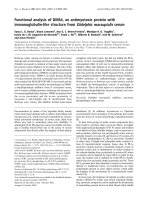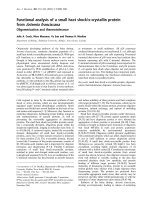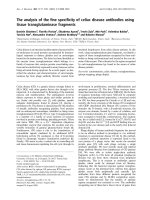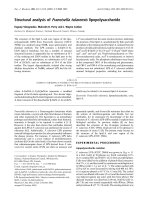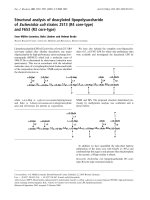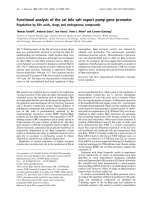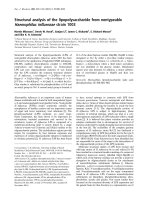Báo cáo y học: "Genetic analysis of HIV-1 Circulating Recombinant Form 02_AG, B and C subtype-specific envelope sequences from Northern India and their predicted co-receptor usage" pot
Bạn đang xem bản rút gọn của tài liệu. Xem và tải ngay bản đầy đủ của tài liệu tại đây (435.49 KB, 6 trang )
BioMed Central
Page 1 of 6
(page number not for citation purposes)
AIDS Research and Therapy
Open Access
Short report
Genetic analysis of HIV-1 Circulating Recombinant Form 02_AG, B
and C subtype-specific envelope sequences from Northern India
and their predicted co-receptor usage
Ujjwal Neogi
1
, Vikas Sood
1
, Arpita Chowdhury
1
, Shukla Das
2
,
Vishnampettai G Ramachandran
2
, Vijesh K Sreedhar
3
, Ajay Wanchu
3
,
Nilanjana Ghosh
1
and Akhil C Banerjea*
1
Address:
1
Virology Laboratory, National Institute of Immunology, Aruna Asaf Ali Marg, New Delhi 110067 India,
2
Microbiology Department,
UCMS and GTB Hospital, Delhi 110095 India and
3
Department of Internal Medicine, PGIMER, Sector 12, Chandigarh 160012 India
Email: Ujjwal Neogi - ; Vikas Sood - ; Arpita Chowdhury - ; Shukla Das - ;
Vishnampettai G Ramachandran - ; Vijesh K Sreedhar - ; Ajay Wanchu - ;
Nilanjana Ghosh - ; Akhil C Banerjea* -
* Corresponding author
Abstract
HIV-1 epidemic in India is largely driven by subtype C but other subtypes or recombinants have
also been reported from several states of India. This is mainly due to the co-circulation of other
genetic subtypes that potentially can recombine to generate recombinant/mosaic genomes. In this
study, we report detail genetic characterization of HIV-1 envelope sequences from North India
(Delhi and neighboring regions). Six of 13 were related to subtype C, one B and the rest six showed
relatedness with CRF02_AG strain. The subtype C possessed the highly conserved GPGQ motif
but subtype B possessed the GPGR motif in the V3 loop as observed earlier. While most of the
sequences suggested CCR5 co-receptor usage, one subtype C sample clearly indicated CXCR4
usage. A successful mother to child transmission was established in two pairs. Thus, co-circulation
of multiple subtypes (B and C) and the recombinant CRF02_AG strains in North India suggests a
rapidly evolving scenario of HIV-1 epidemic in this region with impact on vaccine formulation. Since
this is the first report of CRF02_AG envelope from India, it will be important to monitor the spread
of this strain and its impact on HIV-1 transmission in India.
Introduction
HIV-1 displays a tremendous amount of genetic diversity.
The binding of the HIV-1 to host cells is mediated by enve-
lope glycoprotein. When the HIV-1 envelope protein
binds to its primary receptor CD4, it undergoes conforma-
tional changes and it then binds to one of the coreceptors
(chemokine receptor CCR5, CXCR4 or others) via its V3
loop. This tri-molecular interaction leads to the viral
membrane fusion [1]. HIV-1 envelope is composed of rel-
atively conserved (C1 to C5) and variable regions (V1 to
V5). The V3 region elicits neutralizing antibodies and also
govern co-receptor usage [1,2]. Replacements in the V3
region with basic amino acids are associated with CXCR4
usage [2,3]. Subtypes A and C usually contain a highly
conserved GPGQ amino acid motif, while GPGR is the
predominant motif in the V3 loop of subtype B envelopes
[4,5]. Mutational patterns in the V3 loop region are likely
to be of clinical significance as they can influence their
Published: 3 December 2009
AIDS Research and Therapy 2009, 6:28 doi:10.1186/1742-6405-6-28
Received: 21 July 2009
Accepted: 3 December 2009
This article is available from: />© 2009 Neogi et al; licensee BioMed Central Ltd.
This is an Open Access article distributed under the terms of the Creative Commons Attribution License ( />),
which permits unrestricted use, distribution, and reproduction in any medium, provided the original work is properly cited.
AIDS Research and Therapy 2009, 6:28 />Page 2 of 6
(page number not for citation purposes)
susceptibility to known CCR5 inhibitors. Although all
HIV-1 genetic subtypes originated in Africa, it is not fully
understood how certain subtypes dominate different
regions of the world. For e.g. subtype B predominates in
US and UK but subtype C is predominant in India, some
parts of Asia and Africa [6].
It is fairly well established that HIV-1 that uses CCR5
chemokine receptor (R5-tropic) is transmitted preferen-
tially than the ones that use CXCR4 chemokine receptor
[7]. Individuals with a 32 bp deletion in the CCR5 open
reading frame (ORF) are largely protected against HIV-1
infection [7-9]. Approximately 50% of HIV-1 subtype B
infected individuals show HIV-1 co-receptor switch from
CCR5 to CXCR4 which is associated with rapid progres-
sion of HIV/AIDS [10]. This is observed mainly in US and
UK where subtype B predominates. However, in India,
where subtype C predominates, the coreceptor switch has
not been observed [11]. Replacements of charged amino
acids within the V3 region are known to alter the co-recep-
tor usage [2,3,12]. Genetic variations in the subtype C
HIV-1 envelope sequences have recently been reported
from Southern India with some strains exhibiting multi-
ple co-receptor usage, including CXCR4 chemokine recep-
tor, present predominantly on T-helper lymphocytes
[13,14]. It is noteworthy that we recently reported novel
B/C LTR [15] and Vpr B/C/D sequences from North India
[16].
Given the large size of India, and with increasing global
travel, it is likely that subtypes other than B may also co-
circulate, creating an ideal situation for the formation of
recombinants. With this in mind, we genetically charac-
terized the HIV-1 envelope sequences from HIV-1 infected
individuals from Northern India and report the presence
of HIV-1 CRF02_AG for the first time.
Methods
Genomic DNA isolation and Polymerase chain reaction
Genomic DNA was isolated from fresh peripheral blood
collected in EDTA using a kit from Qiagen (QIAamp
Blood Minikit) as described before by us [8,9]. All requi-
site ethical clearances were obtained before initiating this
study. All the polymerase chain reactions (PCRs) were
performed with high fidelity Taq DNA polymerase (Ex-
Taq, Takara, Japan) using the following primers:
Forward primer: 5'-ATGGGATCAAAGCCTAAAGCCAT-
GTG
Reverse primer: 5'-AGTGCTTCCTGCTGCTCCCAAGAAC-
CCAAG
Approximately 1.25 Kb DNA fragment corresponding to
V1 to V5 region was amplified initially. Thereafter, 700 bp
fragment (V3 to V5) was amplified using two internal sets
of primers with following sequences:
Forward primer: CTGTTAAATGGCAGTCTAGC
Reverse primer: CACTTCTCCAATTGTCCCTCA
The cycling conditions for amplifying both the fragments
were: 35 cycles at 98°C for 15 sec, 55°C for 30 sec and
72°C for 1 min with a final extension at 72°C for 10 min.
PCR-amplified DNA was cloned into pGem-T expression
vector (Promega Biotech. WI, USA) and sequenced in
both directions using T7 and SP6-specific primers. The
sequence from one representative clone from each sample
was used to carry out phylogenetic analysis and sequence
comparisons. The final concentration of MgCl
2
was 20
mM for both the PCRs. Mother and child samples were
processed separately to avoid cross contamination.
Patient population and genetic analysis
We carried out genetic analysis of 13 HIV-1 envelope
sequences from Northern India. Nine unrelated and 2
mother-child pairs (Pair 1, D & E 57 and Pair 2, D & E 58)
were selected randomly from two locations (one from
GTB Hospital, Delhi - Samples ND1 to 5, all from com-
mercial sex workers-CSW) and the rest were from Punjab/
Haryana region. Primers were designed to carry out nested
PCR as described earlier. It is noteworthy that we were
unable to amplify envelope sequences from several sam-
ples which may be due to extreme genetic variability and
therefore difficult to draw conclusions about the fre-
quency of any genetic subtype from this study. Alterna-
tively, since most of the HIV-1 infected individuals were
on antiretrovirals, the amounts of proviral DNA may have
been too small to amplify. Sequences were compared with
reference strains (figure 1) (Los Almos-http://
www.hiv.lanl.gov). At least 4 independent clones were
analyzed from each sample and only one representative
clone from each sample was genetically analyzed. Multi-
ple sequence analysis was performed in ClustalW 1.8.3
obtained from DNA data bank of Japan (DDBJ) website
/>. The phyloge-
netic analysis was carried out using MEGAA 4.1 (beta)
software. Genotyping was carried out using viral genotyp-
ing tools located at NCBI />projects/genotyping/formpage.cgi, REGA subtyping tool
ver 2.0 /> and
Recombination Identification Program (RIP) 3.0. http://
www.hiv.lanl.gov/content/sequence/RIP/RIP.html.
Potential N-glycosylation sites were calculated using N-
GlycoSite program />sequence/GLYCOSITE/glycosite.html.
Results and discussion
All of the HIV-1 infected individuals were infected
through heterosexual route (except mother-child pair)
AIDS Research and Therapy 2009, 6:28 />Page 3 of 6
(page number not for citation purposes)
and their CD4 count varied from 120 - 150 (sample A81
& 82) and between 400-500 (D57 and D58). Most of
them were under 1
st
line of antiretroviral treatment. The
GPGQ motif present in the middle of the V3 loop was
conserved among all subtype C and CRF_02 AG strains.
Remarkably 5 of subtype C samples showed conservation
of A residue just downstream of GPGQ motif (not
observed in consensus C) and 4 of them showed H to Y
change just prior to the second cysteine of the V3 region
(figure 1). The subtype B sample (VT5) possessed the
GPGR amino acid motif at the crown of the V3 loop as
expected. It is noteworthy that we recently reported novel
mosaic B/C HIV-1 LTR and B/C/D recombinant Vpr struc-
tures from the same region of India (Punjab/Haryana
region) [15,16]. Group M subtype reference sequences
along with outlier sequences were downloaded from Los
Almos HIV data base. The sequences were subjected to
various genetic subtyping tools (Phylogenetic Analysis,
RIP 3.0, Viral Genotyping Tools and Rega Subtyping).
This analysis indicated that 6 of 13 were related to subtype
C, one B and the rest 6 showed resemblance with
CRF02_AG strain (figure 2). Successful mother-to-child
transmission was detected in both the pairs (Bootstrap
value 99 in pair 1 and 71 in Pair 2) as judged by high
bootstrap value (figure 2). It is noteworthy that no
changes in the V3 sequences were observed in both the
mother-infant pairs. Maximum intra-patient proviral
diversity was observed in two samples (A81 and C5)
(manuscript under preparation). It was reported earlier
that subtype determination based on phylogenetic analy-
sis should also be confirmed by using other tools or signa-
ture sequences present in V3 region [17]. Representative
subtype sequences identified by RIP 3.0 program are given
(additional file 1). Each curve is a comparison between
the envelope regions being analyzed (query- as indicated
at the top of each square) and multiple reference
sequences downloaded from the data bank. Using this
kind of analysis, HXB2 (panel A) and an isolate with an
accession number FJ769836 (panel B), were identified as
subtype B; isolate FJ968673 as CRF_02AG (panel C) and
isolate with an accession number FJ968672 as subtype C.
The most remarkable finding was the predominance of
CRF02_AG strain among the unrelated commercial sex
workers (CSWs) from Delhi (Capital of India) region. All
the isolates from Punjab/Haryana region showed related-
ness with consensus C. This recombinant form is predom-
inantly found in Africa (Cote Divoire, Mali, Senegal,
HIV-1 envelope sequence comparison and coreceptor usageFigure 1
HIV-1 envelope sequence comparison and coreceptor usage. HIV-1 envelope gene was amplified from infected individ-
uals and subjected to sequencing as described in the text. Only the V3 loop region sequences with short flanking constant
regions are shown with their accession numbers, their subtype assignment and possible co-receptor usage. Dots in the
sequence indicate identity with consensus C, B, 02_AG and A sequences; asterisk indicates identical amino acids; single dot at
the bottom of four groups of samples represents semi-conserved substitution of amino acids and double dots represent con-
served substitution. Subtypes were determined using Viral Genotyping Tool, REGA Subtyping Tool and RIP 3.0 with maximum
blast identity.
&R5HFHSWRU8VDJH
0XOWLSOH6HTXHQFHDOLJQPHQWRI9UHJLRQRIJS
$FF1R
6XEW\SHV
:HE3660 *HQR3KHQR
&9/RRS&
&21B&9+/1(69(,9&75311175.6,5,*3*47)<$7*',,*',54$+&1,6('.:1.7/4
$<116+/,7576$<<'.+7(6$9$5<19$
$,67$*17.(1
''4355<1(
('4355<1(
'
,6$*17.(1
(
,6$*17.(1
)-
)-
)-
)-
)-
)-
&
;
5
5
5
5
5
;
;
5
5
5
5
&21B%94/1769(,1&75311175.6,+,²*3*5$)<77*(,,*',54$+&1,65$.:117/.4,
975495.10+,9&65$1*03/15/$
)-
%
;
;
&21B$*94/9.39.,1&75311175.695,*3*47)<$7*',,*',54$+&19657.:1
&7(5777(49.*<3<
)-
&5)B$*
;
5
&21B$94/7.39.,1&75311175.6,5,*3*4$)<$7*',,*',54$+&19656(:1.7/4.9
1'(597(<7.+4
1')(597(<7.+4
1'(597(<7.)+4
1'6(597(<77.)+4
1'(597(<7.+4
&21B$*9977.14
)-
)-
)-
)-
)-
&5)B$*
5
5
5
5
5
5
5
5
5
5
AIDS Research and Therapy 2009, 6:28 />Page 4 of 6
(page number not for citation purposes)
Phylogenetic analysis of the HIV-1 envelope sequences from North IndiaFigure 2
Phylogenetic analysis of the HIV-1 envelope sequences from North India. All the reference sequences from M-group
& outlier group were retrieved from Los Almos Data Base and used for constructing neighbor joining phylogenetic tree. Indian
CRF02_AG strains are represented as 'Black Circles'; 'Black Square' for subtype C; and 'Black Diamond' as subtype B. The evo-
lutionary history was created using Neighbor-Joining Method in MEGA4. Similar evolutionary pattern was detected when Max-
imum Likelihood and UPGMA methods were used (data not shown). Mother-child pairs were shown by filled and empty circles
by numbers (1 and 2). Empty circles denote maternal envelope sequences while filled circles denote infant envelope sequences.
1,,*7%,1'1')-
1,,*7%,1'1')-
1,,*7%,1'1')-
1,,*7%,1'1')-
$*1(1($-
1,,*7%,1'1')-
$*6(61$-
1,,3*,,1'&)-
$*''%61$)
$*''61$)
5HI$$836'D\'4
5HI$.(4$)
5HI$*1*[,%1*/
5HI$*&0S%'$<
5HI+%(9,$)
5HI+%(9,$)
5HI$(7+&08
5HI$(7+7+$%
5HI*%('5&%/$)
5HI-&'-'&.7%()
5HI-6(6($)
5HI*.(++$)
5HI$&'&'.7%$)
5HI$&<&<$)
5HI)%(9,$)
5HI%)5+;%/$,,,,%%58.
1,,3*,,1'97)-
5HI%1/7$<
5HI)%5%5$)
5HI'&0&0+$/$<
5HI.&'(47%&$-
5HI.&003$-
1,,3*,,1'()-
1,,3*,,1'')-
5HI&%5%5G8
5HI&(7(7+8
5HI&,1,1$)
1,,3*,,1'$)-
1,,3*,,1'()-
1,,3*,,1'')-
1,,3*,,1'$)-
5HI'&'(/,.
5HI2616(03$-
c
n
o
d
6XEW\SH&
6XEW\SH%
&5)B$*
AIDS Research and Therapy 2009, 6:28 />Page 5 of 6
(page number not for citation purposes)
Ghana and Cameroon etc.) followed by Korea, Spain and
France. The potential glycosylation sites present in V3 to
V5 region varied from 7 (A81) to 15 (ND5 (data not
shown). This is important because in some instances
hypo-glycosylated forms of envelope have been associ-
ated with better transmission and in their ability to inter-
act with neutralizing antibody [18].
It was remarkable that sample A81 clearly showed CXCR4
coreceptor usage by both the programs (WebPSSM and
Geno2Pheno) designed to predict HIV-1 coreceptor
usage. This is important because earlier studies with
Indian subtype C envelope showed exclusive use of CCR5
co-receptor [11]. It is important to note that Samples A82
and C5 showed discrepancy in their predicted coreceptor
usage and this is because the two programs use different
parameters [19,20].
Successful transmission of virus (judged by high boot-
strap values) was observed in both the mother-child pair
samples. It is important to study the functional implica-
tions of the changes in the viral gene sequences between
mother-infant pairs to understand the molecular basis of
successful transmission [21]. VT5 (subtype B) sample, as
expected, showed CXCR4 usage and all of the CRF02_AG
strains showed CCR5 usage.
In summary, we show for the first time presence and trans-
mission of CRF02_AG HIV-1 strain in India (Delhi - Cap-
ital of India) and presence of subtypes B and C in North
India. These observations will impact on the T-cell
epitope based vaccine. The existence of multiple HIV-1
genetic subtypes in this region is likely to generate novel
and complex recombinants.
Competing interests
The authors declare that they have no competing interests.
Authors' contributions
UN, VS, NG and AC carried out the experiments. SD, VGR,
VKS, AW were responsible for providing the blood sam-
ples and their clinical characteristics. ACB is the principal
investigator responsible for designing the work and writ-
ing the manuscript. VS and UN contributed equally to this
work.
Additional material
Acknowledgements
This study was supported by grants from Department of Biotechnology
(DBT), Indian Council of Medical Research and National Institutes of
Health, USA, to ACB, AW and to the National Institute of Immunology,
New Delhi. This work was partially supported by the National Bio-Science
Award of DBT to ACB.
References
1. Dragic T, Litwin V, Allaway GP, Martin SR, Huang KA, Nagashima A,
Cayanan C, Maddon PJ, Koup RA, Moore JP, Paxton WA: HIV-1
entry into CD+ cells is mediated by the chemokine receptor
CC-CKR-5. Nature 1996, 381:667-673.
2. Hoffman NG, Seillier-Moiseiwitsch F, Ahn J, Walker JM, Swanstrom :
Variability in the human immunodeficiency virus type 1
gp120 Env protein linked to phenotype associated changes in
the V3 loop. J Virol 2002, 76:3852-3864.
3. Milch LB, Margolin B, Swanstrom R: V3 loop of the immunodefi-
ciency virus type 1 Env protein: interpreting sequence varia-
bility. J Virol 1993, 67:5623-5634.
4. Korber BT, MacInnes K, Smith RF, Myers G: Mutational trends in
V3 loop protein sequences observed in different genetic lin-
eages of human immunodeficiency virus type 1. J Virol 1994,
68:6730-6744.
5. Stanfield RL, Gorny MK, Zolla-Pazner S, Wilson IA: Crystal struc-
tures of human immunodeficiency virus type 1 (HIV-1) neu-
tralizing antibody 2219 in complex with three different V3
peptides reveal a new binding mode for HIV-1 cross-reactiv-
ity. J Virol 2006, 80:6093-6105.
6. Hemelaar J, Gouws E, Ghys PD, Osmanov S: Global and regional
distribution of HIV-1 genetic subtypes and recombinants in
2004. AIDS 2004, 20:W13-23.
7. Berger EA, Murphy PM, Farber JM: Chemokine receptors as HIV-
1 coreceptors: Roles in viral entry, tropism, and disease.
Annu Rev Immunol 1999, 17:657-700.
8. Husain S, Goila R, Shahi S, Banerjea AC: First report of a healthy
Indian heterozygous for Δ32 mutant of HIV-1 coreceptor-
CCR5 gene. Gene 1998, 207:141-147.
9. Husain S, Goila R, Shahi S, Banerjea AC: Inheritance pattern of
mutant human immunodeficiency virus type 1 coreceptor
gene in an Indian family. J Hum Virol 1998, 1:187-192.
10. Connor RI, Sheridan KE, Ceradini D, Choe S, landau NR: Change in
coreceptor usage correlates with disease progression in
HIV-1 infected individuals. J Exp Med 1997, 185:621-628.
11. Cecilia D, Kulkarni SS, Tripathy SP, Gangakhedkar RR, Paranjape RS,
Gadkari DA: Absence of coreceptor switch with disease pro-
gression in human immunodeficiency virus infection in India.
Virology 2000, 271:253-258.
12. Pastore C, Nedelle R, Ramos A, Pontow S, Ratner L, Mosier DE:
Human immunodeficiency virus type 1 coreceptor switch-
Additional file 1
Identification of HIV-1 subtypes. RIP tool available in Los Alamos HIV
Database was used to type four representative query sequences (HXB2 -
panel A; FJ769836 - panel B; FJ968673 - panel C and FJ968672 - panel
D) as indicated at the top of each square. Similarity of the sequences was
compared with various subtypes with a window size 400 bp having signif-
icant threshold (0.9). It is noteworthy that HXB2 (Accession no.
K03455, panel A) and FJ769836 (NII-PGI-IND-VT5) (Panel B) were
identified as subtype B (lemon green); FJ968673 (NII-GTB-IND-ND1)
as 02_AG (dark green, panel C) and FJ968672 (NII-PGI-IND-E58) as
subtype C (blue, panel D).
Click here for file
[ />6405-6-28-S1.PDF]
Publish with BioMed Central and every
scientist can read your work free of charge
"BioMed Central will be the most significant development for
disseminating the results of biomedical research in our lifetime."
Sir Paul Nurse, Cancer Research UK
Your research papers will be:
available free of charge to the entire biomedical community
peer reviewed and published immediately upon acceptance
cited in PubMed and archived on PubMed Central
yours — you keep the copyright
Submit your manuscript here:
/>BioMedcentral
AIDS Research and Therapy 2009, 6:28 />Page 6 of 6
(page number not for citation purposes)
ing: V1/V2 gain-of-fitness mutations compensate for V3 loss-
of fitness mutations. J Virol 2006, 80:750-758.
13. Dash PK, Sidappa NB, Mangaiarkarasi A, Mahendarkar AV, Roshan P,
Anand KK, Mahadevan A, Satishchandra P, Shankar SK, Prasad VR,
Ranga U: Exceptional molecular and coreceptor-requirement
properties of molecular clones isolated from an Human
Immunodeficiency Virus type-1 subtype C infection. Retrovi-
rology 2008, 5:25.
14. Gharu L, Ringe R, Pandey S, Paranjape R, Bhattacharya J: HIV-1 clade
C env clones obtained from an Indian patient exhibiting
expanded coreceptor tropism are presented with naturally
occurring unusual amino acid substitutions in V3 loop. Virus
Res 2009, 144:306-314.
15. Neogi U, Sood V, Goel N, Wanchu A, Banerjea AC: Novel HIV-1
long terminal repeat (LTR) sequences of subtype B and
mosaic intersubtype B/C recombinants in North India. Arch
Virol 2008, 153:1961-1966.
16. Bano AS, Sood V, Neogi U, Goel N, Kuttiat VS, Wanchu A, Banerjea
AC: Genetic and functional characterization of HIV-1 VprC
variants from North India: Presence of unique recombinants
with mosaic genomes from B, C and D subtypes within the
ORF of Vpr. J Gen Virol 2009, 90:2768-2776.
17. Vasil S, Thakallapally R, Korber BT, Foley BT: Global Variation in
the HIV-1 V3 Region. In Human Retroviruses and AIDS 1998 Edited
by: Korber B, Kuiken CL, Foley B, Hahn B, McCutchan F, Mellors JW,
Sodroski J. Theoretical Biology and Biophysics Group, Los Alamos
National Laboratory, Los Alamos, NM; 1998:III-118-129.
18. Derdeyn CA, Decker JM, Bibollet-Ruche F, Mokili JL, Muldoon M,
Denham SA, Heil ML, Kasolo F, Musonda R, Hahn BH, Shaw GM, Kor-
ber BT, Allen S, Hunter E: Envelope constrained neutralization-
sensitive HIV-1 after heterosexual transmission. Science 2004,
303:2019-2022.
19. Sing T, Low AJ, Beerenwinkel N, Sander O, Cheung PK, Domingues
FS, Büch J, Däumer M, Kaiser R, Lengauer T, Harrigan PR: Predicting
HIV co-receptor usage based on genetic and clinical covari-
ates. Antivir Ther 2007, 12:1096-1106.
20. Jensen MA, Li FS, Van't Wout AB, Nickle DC, Shriner D, He HX,
McLaughlin S, Shankarappa R, Margolick JB, Mullins JI: Improved
coreceptor usage prediction and genotypic monitoring of
R5-to-X4 transition motif analysis of HIV-1 env V3 loop
sequences.
J Virol 2003, 77:13376-13388.
21. Mehta R, Sundaravaradan V, Ahmad N: Mutations generated in
human immunodeficiency virus type 1 long terminal repeat
during vertical transmission correlate with viral gene
expression. Virology 2008, 317:109-118.

